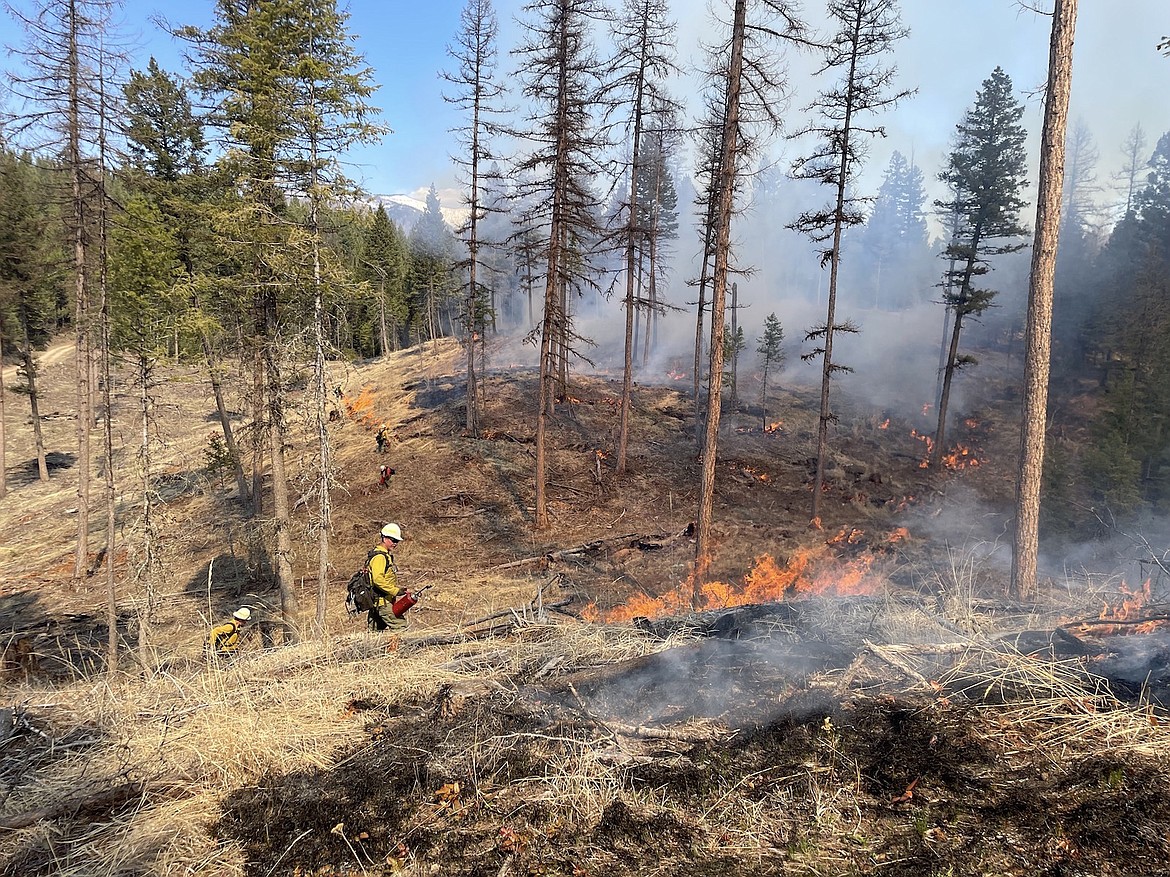Kootenai National Forest plans spring prescribed burns
The Kootenai National Forest is conducting spring prescribed fire projects when weather, fuel conditions and air quality become favorable.
Each project follows a prescribed fire burn plan. The prescribed fire projects are located and designed to be controlled to reduce the potential for adverse effects.
Robust scientific data shows that strategically placed prescribed fire and mechanical treatments are vital to reducing forest fuels, lowering catastrophic wildfire risks and slowing or stopping the progression of wildfires.
These projects will comply with Montana air quality standards and guided by the Montana/Idaho State Airshed Group to reduce the impacts of smoke to our neighbors, cooperators and surrounding communities.
Land and fire managers may opt to cease firing operations early, on the day of ignitions, for smoke dispersal or other factors.
The Libby Ranger District and the Three Rivers Ranger District began conducting prescribed fire operations on Tuesday, April 3.
On the Libby Ranger District, a 96-acre prescribed fire was planned in the Cripple Horse Creek area. This prescribed fire was planned to reduce fuel loading and to enhance wildlife habitat.
The other burn planned for April 3 was on the Three Rivers Ranger District. It was planned along the Kootenai Face road near the Troy shooting range. The purpose of the burn was to reduce fuel accumulations generated from logging activity, increase browse for wildlife and to create openings in the timber for big game, upland and song birds.
Here is a list of planned projects.
Libby Ranger District
East Reservoir Project – This project includes broadcast burning both timber harvest units and natural fuels units located near the Cripple Horse and Canyon Creek drainages northeast of Libby. These treatments will use prescribed fire to create landscapes that are resilient to disturbance, improve wildlife habitat, and reduce hazardous fuels.
Rexford/Fortine Ranger District
Galton Project – This project includes broadcast burning timber harvest units and natural fuels units near Glen Lake. These treatments will use prescribed fire to reduce fuels within the wildland urban interface, improve wildlife habitat and re-introduce fire to forested ecosystems.
Gateway Ecological Restoration Project - Prescribed fire will be used, in the Gateway area north of Eureka, to emulate the “natural ecological role” of fire by not only reducing the surface fuels that have built up since the last prescribed burn treatment, but also stimulating the growth of forage, and improving the overall health of the forest.
McSutton Project – This project includes broadcast burning natural fuels and timber harvest units in the Sutton and Falls Creek drainages southwest of Eureka, MT. These treatments will use prescribed fire to reduce hazardous fuels, improve forest health, and improve wildlife habitat.
North Meadow Hazardous Fuels Reduction Project – This project includes broadcast burning timber harvest units in the Barnaby and Frank Lakes vicinity west of Fortine, MT. These treatments will use prescribed fire to reduce hazardous fuels, improve forest health, and improve wildlife habitat.
Young-Dodge Project – This project includes broadcast burning both timber harvest units and natural fuels units in the West Kootenai vicinity northwest of Eureka, MT. These treatments will use prescribed fire to reduce hazardous fuels which decreases the likelihood of large stand-replacing wildfires, and restore characteristic vegetation patterns, structure, and patch sizes.
Marston Bugs Project – This project includes broadcast burning timber harvest units near Hagadore Lake and Laughing Water Creek drainage. These treatments will use prescribed fire to reduce hazardous fuels, improve forest health, improve wildlife habitat, and restore landscapes affected by Douglas-fir bark beetle infestations.
Three Rivers Ranger District
Lower Yaak, O’Brien, Sheep Project – This project includes broadcast burning both timber harvest units and natural fuels units located near the O’Brien Creek drainage north of Troy. These treatments will use prescribed fire to promote resilient vegetation conditions, improve wildlife habitat, and reduce hazardous fuels while reducing the potential for high intensity wildfire.
South Fork Fuels Project – This project includes broadcast burning timber harvest units located within the Kelsey Creek drainage south of Yaak. These treatments will use prescribed fire to reduce hazardous fuels, improve safety for the public and firefighters and improve forest health.
Starry Goat Project – This project includes broadcast burning timber harvest units and natural fuels units located within the Callahan and Star Creek drainages west of Troy. These treatments will use prescribed fire to promote resilient vegetation conditions, improve wildlife habitat and reduce hazardous fuels while reducing the potential for high intensity wildfire.
Cabinet Ranger District
Cub Creek Salvage Project – This project includes broadcast burning timber harvest units located within the Beaver Creek and Haines Gulch drainages south of Trout Creek. These treatments will use prescribed fire to protect health and safety of the public, restore portions of the landscape burned by the Cub Creek wildfire and reduce hazardous fuels.
Helwick Project - This project includes broadcast burning within timber harvest units and located within the Big Beaver Creek drainage south of Trout Creek. These treatments will use prescribed fire to increase resilience to insects and diseases, reduce hazardous fuels within the wildland urban interface and improve big game forage.

